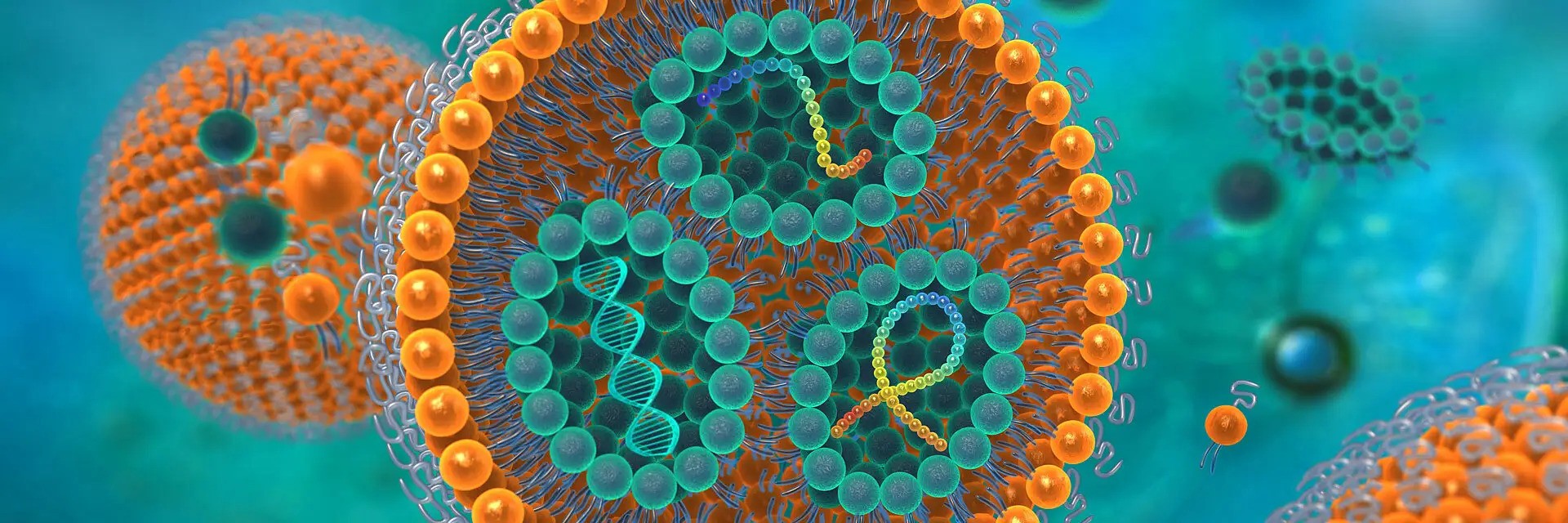
samples.

samples.

Your Partner in the Modern Lab
- A Curated Instrument Portfolio
- Application-Specific Solutions
- Solutions for Any Budget
- Flexible Payments
- 24/7 Support
By scientists, for
scientists.
We believe that groundbreaking research shouldn’t be limited by budget or geography. Your work is too important to be compromised by the false choice between overpriced legacy brands and underperforming equipment.
As scientists, we founded NanoExact to solve this problem. Our mission is to find and validate the exceptional instruments you’ve been looking for—tools that deliver the data quality and reliability you demand, at a price that respects your budget. We do the due diligence, so you can focus on the discovery.
Get in Touch
With a single and continuous measurement, VASCO KIN™ gives you access to all characterization data of your reaction (size distribution evolution over time).

Lipid Nanoparticle Formulation (LNP): How to boost efficiency and scale faster
The global demand for LNPs is soaring. Valued at US $789.0 million in 2022, the global LNP market is expected to ramp up to US $3.3 billion by 2033 (Future Market Insights 2022 report). This rapid growth may come as no surprise to those in the pharmaceutical and cosmeceutical industries due to the various benefits LNPs offer.
Lipidic nanoparticle advancements are responsible for the success of COVID-19 mRNA vaccines that have saved millions of lives. And the advantages of LNPs go far beyond vaccine delivery. They help improve drug delivery in targeted therapies, reduce the risk of toxicity, and even facilitate the uptake of drugs into cells, making them attractive in developing personalized medicines and anti-aging skincare.
However, with rapid market growth, competition is fierce.
To stay ahead of the competition, CDMOs must scale fast and cost-effectively without compromising quality.
This can be especially significant for LNP production because of the high standards in the pharmaceutical industry. Without efficient manufacturing processes, there may be more product wastage and increased costs.
Unfortunately, a massive barrier to growth is the efficient reproducibility of LNP suspensions. A key issue is analyzing particle size distribution in LNP-based suspensions accurately and efficiently.
In this article, let’s learn why and explore a novel way to eliminate wasted steps in the quality control process, which saves time and costs and can help enhance reproducibility.
Challenges measuring particle size and distribution of turbid LNP-based suspensions
Achieving consistent quality in LNP formulation is no easy task. One of the main obstacles lies in the optimization of manufacturing processes because:
- Specialized DLS (dynamic light scattering) equipment is needed to precisely measure LNP particle size and distribution.
- LNPs can be physically unstable and prone to aggregation, which compromises quality.
- Stringent regulatory requirements for LNP-based products in pharmaceutical and cosmeceutical applications require higher accuracy, consistency, and product reliability.
Consistency in quality requires precise and accurate measurement of particle size, shape, composition, and purity across production batches of lipid nanoparticles. However, with such turbid media, there are considerable difficulties in lipidic nanoparticle analysis and estimating RNA concentration in samples.
Moreover, transporting samples from the manufacturing location to a DLS particle size analyzer to measure particle size, molecular weight, and other parameters can introduce more complications.
Moving samples back and forth to measure particle size is highly inefficient, costly, and negatively impacts quality
Transporting turbid lipid nanoparticle-based solutions can cause significant complications and inefficiencies in the entire process because:
- LNP-based suspensions can be delicate, making them susceptible to settling and aggregation when they move around.
- Based on the amount of movement, the suspension may be agitated, and particle size distribution may be altered along the way, rendering the readings inaccurate.
- With each added step, contamination is a serious concern. Lipid nanoparticles are highly sensitive to environmental factors, and the instruments with which samples are collected and transported may skew results and affect overall quality.
- Minor variations in temperature, humidity, or exposure to contaminants can impact the stability and other material characteristics of the LNP suspensions.
- The turbid nature of the LNP formulations makes it hard to perform direct visualization and measurement of particle size. This means manufacturers have to invest in multiple specialized particle size analyzers in cleanrooms for teams to use in different locations, which drives up costs.
Measuring particle size distribution on site and in real-time can reduce redundancies in the manufacturing process
Eliminating the need to transport samples for quality checks can save time and costs and maintain production quality because:
- Without the need to transport samples, there is a much lower risk of sample degradation or alteration.
- The risk of contamination is lowered significantly without the need to change containers or transport samples to a DLS analyzer.
- Scientists can obtain real-time particle size data on site — ensuring accurate and reliable results.
Portable instruments, such as dynamic light scattering (DLS) systems, offer rapid and non-destructive measurements, enabling researchers to assess the particle size distribution without compromising sample integrity.
Improving particle size measurement efficiency and quality of nanoparticle suspensions at high temperatures
Researchers Navarette et al. (2019) used an innovative DLS particle size analyzer to measure the colloidal stability of molten salt-based nanofluids (which use nanoparticles) for the first time.
Using the device, the scientists studied how silica nanoparticles agglomerate when dispersed in different bases: water, calcium nitrate, and solar salt.
They compared their results with a traditional DLS analyzer available in the market and found that the particle distribution results were similar using both types of particle size analyzers.
The DLS VASCO-KIN particle size analyzer featured an optical laser head that could be taken to the turbid samples located remotely instead of having the samples brought to the device.
Benefits of contactless, remote, real-time particle size analysis
By using an innovative time-resolved DLS (dynamic light scattering) instrument like VASCO-KIN™, researchers gain benefits like:
- Efficiency due to remote monitoring: Leverage the contactless remote optical head DLS probe to measure samples in situ.
- Real-time monitoring through measurement in flowcell: Perform nanoparticle synthesis monitoring and analyze lipid nanoparticle agglomeration and nanoparticle suspension stability of suspensions in real-time to get faster insights.
- Continuous results: Get all characterization data related to a reaction in one single and continuous measurement. This way, you get the whole picture without breaks or measurement errors.
- Variable particle size measurements: Measure even the smallest nanoparticles — from 0.5 nm to 10 µm in a concentration range of up to 40%wt.
- Unprecedented flexibility: The device’s small footprint, ease of movement, and ability to integrate into harsh environments allows ease of use, efficiency, and adaptability.
About VASCO-KIN™ Particle Size Analyzer
VASCO-KIN™ is a next-generation particle size analyzer with a time-resolved instrument that allows you to perform accurate kinetic analysis in nanotechnology.
Using the in situ and contactless remote head, you can measure your liposome and lipid nanoparticles where you prepare your samples; there’s no need to move or disturb them.
The instrument has a frequency stabilized laser and artifact-free avalanche photodiode (APD) detector for high measurement accuracy and extremely low scattering samples.
VASCO-KIN™’s user-friendly software platform Nanokin™ gives you single and continuous measurement readings for all particle characterization data, including size distribution, scattered intensity, correlograms, and much more.
You may want to consider VASCO-KIN™ to measure lipid nanoparticles and lipid-based nanocarriers in research. Based on enhanced mathematical models, the DLS particle size analyzer offers high reliability of results and a 2D color map of particle size distribution over time — valuable insights to propel product quality forward.
Inefficient particle size measurement can lead to variations in the quality of lipid nanoparticles (LNP), which may result in wasted product, time, and increased costs.
Achieving consistent quality is crucial for scalability and maximizing LNP manufacturing.
Learn how VASCO-KIN™can boost efficiency in your LNP formulations at www.nanoexact.io.
Sources:
[1] S. Ghosh, “Lipid nanoparticles market,” Futuremarketinsights.com. [Online]. Available: https://www.futuremarketinsights.com/reports/lipid-nanoparticles-market. [Accessed: 27-Nov-2023].
[2] M. Mehta, T. A. Bui, X. Yang, Y. Aksoy, E. M. Goldys, and W. Deng, “Lipid-based nanoparticles for drug/gene delivery: An overview of the production techniques and difficulties encountered in their industrial development,” ACS Mater. Au, vol. 3, no. 6, pp. 600–619, 2023.
[3] R. E. Young, S. I. Hofbauer, and R. S. Riley, “Overcoming the challenge of long-term storage of mRNA-lipid nanoparticle vaccines,” Mol. Ther., vol. 30, no. 5, pp. 1792–1793, 2022.
[4] N. Navarrete, A. Gimeno-Furió, J. Forner-Escrig, J. E. Juliá, and R. Mondragón, “Colloidal stability of molten salt –based nanofluids: Dynamic Light Scattering tests at high temperature conditions,” Powder Technol., vol. 352, pp. 1–10, 2019.

Anti-counterfeit security ink: Innovative taggant inks with soluble lanthanide-based molecular alloys
Counterfeiting is a growing threat that costs the world USD 500 billion a year, according to the US Chamber of Commerce. Because of this, the demand for anti-counterfeit security inks has surged, with the industry now estimated at over USD 3.3 billion.
To fight increasingly sophisticated counterfeit products, the security ink and pigment industries are racing to pioneer innovative anti-counterfeiting technology.
However, ink manufacturers face a delicate balancing act: creating intricate custom colors for customers, protecting their inks from replication, and ensuring compliance with stringent regulations — all while keeping the solutions affordable for their customers and end users.
Researchers Y.Pointel et al. from France believe colloidal suspensions of lanthanide-based coordination polymer molecular alloys (LnCPMA) may be the answer for anti-counterfeiting applications.
In particular, for quality anti-counterfeit taggant inks.
Let’s learn why.
Lanthanide-based molecular alloys are used as taggants but have a huge disadvantage
Lanthanide-based molecular alloys have been popular for decades. They offer remarkable luminescence and magnetism, which makes them very useful to:
- Develop lighting, LED displays, and optical sensors,
- Encapsulate and deliver drugs for targeted therapies,
- Act as contrast agents in optical imaging and
- Offer security as taggant inks for anti-counterfeiting, tamper evidence, and authentication purposes.
Most of these taggant inks are invisible to the naked eye, ensuring security while offering desirable optical properties that preserve the original look of a brand or document.
They can be highly customized for unique security measures and can be visible when exposed to UV light or infrared light. In many industries, they are considered mandatory anti-counterfeiting methods.
However, a significant challenge for ink manufacturers is that these molecules are not soluble. As a result, they are very difficult to use in their liquid state.
To overcome this hurdle, scientists often have to use workarounds like ultrasound or microwave-assisted irradiation or post-synthetic treatments like suspension in ionic liquids or poly-alcohols or encapsulating the coordination polymer (CP) with an organic polymer.
However, as researchers Y.Pointel et al. point out, these dissolution techniques have several inherent drawbacks.
Challenges with post-synthesis dissolution techniques
Challenges with using standard industry methods to dissolve lanthanide-based coordination polymers include:
- Uncontrolled purity: Inconsistent ink purity may risk non-compliance with regulations and result in a large amount of wasted product.
- Solvent toxicity: Commonly used ionic liquids have been shown to have varying levels of toxicity for humans who come in contact with them when ionic residues remain in the final product or leach into the environment.
- Added costs of the dissolution processes: Producing security inks is an expensive process, and the introduction of new regulations makes it harder to keep costs low while maintaining quality. Post-synthesis dissolution processes add a considerable cost burden.
- Inefficiency: Having to add several dissolution steps after synthesis is not only expensive but also inefficient.
Adding to these issues is that, when used for luminescent inkjet printing applications, blue, green, and red-emitting nanocrystals are stored in their solid state and, when mixed, are often not homogenous.
This property negatively impacts the physical properties and quality of the end product.
Homogeneity of nanometric grains in micropowders is crucial
Nanometric grain homogeneity in the LnCPMA micropowders is essential to ensure:
- Consistency of color,
- Purity of color,
- Excellent optical properties with high visual quality,
- Uniform light emissions for even illumination,
- Consistency and reliability in how LEDs or lasers perform and
- Quality control of the final product.
So, how do security ink manufacturers ensure high luminescence, a broad spectrum of tunable colors, excellent security, and maintain end-to-end quality while controlling costs?
Soluble lanthanide-based molecular alloys offer promise in taggant inks
Y.Pointel et al. report that LnCPMAs that are iso-structural to [Eu2(dcpa)3(H2O)]∞, where H2dcpa stands for 4,5-dichlorophthalic acid, demonstrate potential for use in anti-counterfeit taggant inks.
Benefits of soluble LnCPMAs
- Bright luminescence in both solid and liquid states,
- A broad range of highly tunable colors,
- More cost-effective processes versus standard ones,
- High stability, and
- Higher quality control due to highly homogenous nanometric grains in the LnCPMA micropowders.
Creating the soluble LnCPMA powders
- Powder X-ray diffraction,
- Electron dispersive spectroscopy (EDS) measurement and
- Optical and colorimetric measurements.
The researchers focused on end-to-end quality and efficiency with their lipidic nanoparticle (LNP) analysis; they measured particles in the colloidal suspension using a DLS particle size analyzer with an in situ and contactless remote optical head.
Having an in situ and contactless remote optical head for a particle size analyzer is helpful because it allows measurements to be taken without disturbing the sample, making it ideal for situations where sampling could modify the sample state, when measuring in limited spaces, and while dealing with valuable or hostile samples.
Final thoughts
- The anti-counterfeit security ink industry is in huge demand due to soaring counterfeiting activity.
- Ink manufacturers use lanthanide-based molecular alloys in anti-counterfeiting applications as taggants in security inks.
- However, a considerable challenge with common lanthanide-based molecular alloys is that they are not soluble, making it hard to control the physical properties and end quality of the product, costs, and efficiency of the entire process.
- Researchers from France believe that a colloidal suspension of lanthanide-based coordination polymer molecular alloys may be the answer to making highly luminescent taggant inks with tunable colors that meet regulations, improve efficiency, and cost-effectiveness.
- To achieve end-to-end quality and efficiency when making the LnCPMA, the scientists used a DLS particle size analyzer with an in situ and contactless remote optical head.
About VASCO-KIN™ Particle Size Analyzer
VASCO-KIN™ is a next-generation particle size analyzer with a time-resolved instrument that allows you to perform accurate kinetic analyses. Using the in situ and contactless remote head, you can measure your liposome and lipid nanoparticles where you prepare your samples; there’s no need to move or disturb them.
Using VASCO-KIN™, You can measure nanoparticle synthesis, agglomeration, or the stability of suspensions and perform nanoparticle synthesis monitoring in real time.
The instrument comes with a frequency-stabilized laser and artifact-free avalanche photodiode (APD) detector for high measurement accuracy and extremely low scattering samples.
VASCO-KIN™ also has a user-friendly software platform that gives you single and continuous measurement readings for all particle characterization data, including size distribution, scattered intensity, correlograms, and much more.
You may want to consider VASCO-KIN™ to measure nanoparticles in your research. Based on enhanced mathematical models, the DLS particle size analyzer offers high reliability of results and a 2D color map of particle size distribution over time — valuable insights to propel your research forward.
Want to learn how VASCO-KIN™ can help you achieve your results more efficiently?
Visit www.nanoexact.io to learn more.
Sources
- Counterfeit products cost the global economy over $500 billion a year. That’s why the private sector is partnering with U.S. Customs and Border protection to raise awareness nationwide to educate Americans about the dangers of counterfeits. (2022, August 11). Uschamber.com; U.S. Chamber of Commerce. https://www.uschamber.com/intellectual-property/back-to-school-business-and-law-enforcement-team-up-to-protect-students-parents-and-teachers-from-counterfeit-goods
- Security Inks Market size, share, growth analysis, by type, application — industry forecast 2023–2030. (n.d.). Skyquestt.com. Retrieved October 26, 2023, from https://www.skyquestt.com/report/security-inks-market
- Pointel, Y., Daiguebonne, C., Suffren, Y., Le Natur, F., Freslon, S., Calvez, G., Bernot, K., Jacob, D., & Guillou, O. (2021). Colloidal suspensions of highly luminescent lanthanide-based coordination polymer molecular alloys for ink-jet printing and tagging of technical liquids. Inorganic Chemistry Frontiers, 8(8), 2125–2135. https://doi.org/10.1039/d1qi00060h
- Valtchev, V., & Tosheva, L. (2013). Porous nanosized particles: Preparation, properties, and applications. Chemical Reviews, 113(8), 6734–6760. https://doi.org/10.1021/cr300439k
- Kuroda, K. (2022). A simple overview of toxicity of ionic liquids and designs of biocompatible ionic liquids. New Journal of Chemistry, 46(42), 20047–20052. https://doi.org/10.1039/d2nj02634a

Social